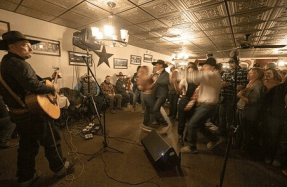
SHE STANDS IN THE WIND, 8,510 feet atop the jagged Continental Divide. At a place where the Northern Rocky Mountains slice through the dry brown summer landscape like a saw blade, she is always waiting, watching over the people of Butte, Montana. Her broad, blank face is framed by a veil made of steel and her hands emerge from the folds of a long flowing dress, palms forward. In the dark night sky, she shines bright white, lit up by spotlights near her feet. Officially, she is called Our Lady of the Rockies, but most people here simply call her “the Lady.”
At 5,539 feet above sea level — higher than any other major city in the state — Butte is often frigid, and temperatures hover near zero for months. Most of the year, the statue of the Lady is surrounded by deep, impassable snow, so it’s only during the brief window of warm summer weather that visitors can see her up close. Ambitious pilgrims might hike up steep switchbacks to get to her, but most pay a few dollars to take a bus up a winding, rocky dirt road carved into the mountainside.
The statue was constructed in 1985, when the economy of Butte, which relied on jobs at the Anaconda Copper Mining Company and the Atlantic Richfield Company, all but collapsed as the mines largely shut down. A group of local men banded together to build a statue of the Virgin Mary, a project originally conceived by a local worker whose wife was severely ill. Guided, they felt, by a divine hand, they coated steel panels in white paint and welded them together until, eventually, the shape of a woman, 90 feet tall, emerged. Once she finally stood in place, they dedicated her “to women everywhere, especially mothers.”
“The story is so Butte,” Christy Hays Pickett, a local folk musician, said, standing at the foot of the Lady last summer. FromButte, the Lady looks immaculate, butup close, she looks tired and worn, rumpled in places, the white paint now blotchy and gray, as if the hem of her dress has been dragging around in the dirt of some earthly, non-celestial place.
“All these people came together to make this,” Hays Pickett said. “And they did it because so many people were out of work. It was this true labor of love, and I feel like that story resonates in this community over and over again.”
Butte is a city of stories about hardrock miners, labor unions warring in the streets, legendary rebels and insatiable corporate greed. These tales of work and workers are passed down through generations in high school classrooms, over dinner tables and at local landmarks. In these stories, Butte is defined by all it once had, everything workers endured and everything they lost.
Hays Pickett turned to follow the statue’s long gaze: To the west, range after range after range of mountains fade out to the horizon in shades of withering blue. Below, next to Butte’s compact grid of streets and homes, three gigantic chasms dwarf the city, each gouged out of the Earth by miners and their machines.
Hays’ husband was down there, driving a truck across the bottom of one of the craters — an active copper and molybdenum mine. Another is a massive tailings pond, though “pond” undersells its size: It is an enormous and unnatural lake where the active mine’s waste is stored, held back by a 750-foot-high dam that Montana Resources is currently making even taller.
And nestled closest to Butte is the hole that gave it its modern-day reputation: the Berkeley Pit. It’s a former copper mine that closed in 1982, now filled with 50 billion gallons of poisonous blue-green water that the U.S. Environmental Protection Agency said will require treatment “in perpetuity,” like a wound that will never heal. Since 1983, when the EPA declared the area a Superfund site, it has been one of the largest cleanup projects in the country.
Around Montana, people raise their eyebrows or turn up their noses at the mere mention of Butte because of this: it is the place with the toxic pit. And, somewhere along the way, Butte seemed to understand it was being ostracized and decided to be the one doing the ostracizing. Locals began calling their city “Butte, America,” forgoing any state affiliation. They described themselves as “Butte Tough” and splashed “Butte vs. Everybody” across T-shirts — delineations that felt less like civic slogans, and more like civic callouses.
Mining employs only about 300 people in Butte now, but it still shapes life here. Old-timers might tell someone to “tap ’er light” — a callback to when dynamite was tapped carefully into underground holes, but today suggests that someone should both have a good day and stay alive as best they can. Visitors pay $2 to gaze into the




